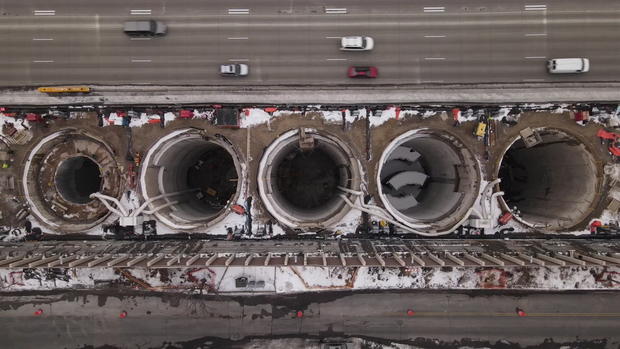What Is MnDOT Building Along I-35W In South Minneapolis?
Originally published March 8
MINNEAPOLIS (WCCO) -- Thousands drive past it every day, but it takes a bird's eye view to see the unique construction project happening along I-35W in south Minneapolis.
The multi-year effort is to address a persistent problem that often stops traffic for hours and can be dangerous for drivers.
This time of year, heavy snow and ice are the main worries for drivers along the busy stretch of I-35W in south Minneapolis. But come spring and summer it's heavy rain, which has at times overwhelmed the drainage system below the highway.
Engineers with the Minneapolis Department of Transportation (MnDOT) said when the drainage tunnel fills up it becomes pressurized, causing storm water to overflow out of manholes. The water then floods the pavement to the point of stopping traffic.
Preventing this from happening again is why MnDOT crews have been busy off the shoulder of the northbound lanes near 42nd Street. They're building a storm water storage facility.
Construction started in 2019, but the idea has been in the works for years, well before the start of the Downtown To Crosstown project in 2017.
The underground structure will consist of six tanks, only five of which are visible right now. Each span about 100-feet below ground with an inside diameter of 42 feet, or about the length of a school bus.
All of them are connected. That means the tanks will fill simultaneously, from the top, when it rains. Simply put, the tanks can hold what seems like a small pond. MnDOT says they have a 4.56-million-gallon capacity combined. That's the equivalent of seven Olympic-sized swimming pools.
Once the drainage tunnel beneath the highway has low-level water, pumps will slowly empty the tanks into the tunnel. The water ends up in the Mississippi River.
MnDOT engineers said flooding used to happen every year or two along this stretch of highway. Thanks to this project, it might happen once every decade.
The storage facility is also equipped with sensors, alerting MnDOT ahead of time when flooding might occur as opposed to it erupting by surprise.
Once finished, the tanks will be underground, out of sight, covered by pavement.
The project is expected to be complete around the summer 2023. However, it's possible the tanks will start collecting storm water as soon as this fall.




